Exploring the Significance of Media for Childcare Services in California
While some people may worry about the negative effects of media on children, media can also be a powerful tool for learning and development.

Media is ubiquitous in our lives, and children are no exception. Children are exposed to media from a young age through television, movies, games, apps, and books. While some people may worry about the negative effects of media on children, media can also be a powerful tool for learning and development.
In California, childcare providers have a unique opportunity to use media to support children's learning and development. By choosing age-appropriate media and using it in a balanced way, childcare providers can help children to:
- Learn new concepts and skills in a fun and engaging way
- Develop their creativity and imagination
- Explore different cultures and perspectives
- Enhance their social and emotional development
- Develop digital literacy skills
Benefits of media for educators
Media can be a valuable tool for childcare educators in a number of ways. For example, media can be used to:
- Introduce new concepts and skills. Media can be used to introduce children to new concepts and skills in a fun and engaging way. For example, an educator could use a documentary to teach children about a theme or a video from far-off places to teach children about concepts they otherwise wouldn't be exposed to.
- Provide opportunities for exploration and discovery. Media can provide children with opportunities to explore different cultures, perspectives, and ideas. For example, children could watch a movie about a different country or see the life cycle of ladybugs.
- Encourage creativity and imagination. Media can encourage children to be creative and imaginative. For example, children could watch a movie about art and then create their own artwork, or they could play a video game that requires them to use their problem-solving skills.
- Support social and emotional development. Media can be used to support children's social and emotional development. For example, children could watch a show about friendship and then discuss the characters' actions, or they could play a video game that requires them to cooperate with others.
Benefits of media for families
Media can also be a valuable tool for families. For example, media can be used to:
- Bond with children. Media can provide families with opportunities to bond with their children through shared experiences. For example, families could watch a kid's show and then discuss the topic of the show, what they liked or disliked about it, or play as the TV show characters together.
- Support children's learning and development at home. Media can be used to support children's learning and development at home. For example, parents could read books with their children or help them to choose educational video games.
- Enhance children's creativity and imagination. Media can enhance children's creativity and imagination. For example, parents could encourage their children to create their own artwork or stories inspired by the media they consume.
- Help children to develop digital literacy skills. Specific educational apps can help children develop digital literacy skills, such as responsibly evaluating information and using technology. For example, parents can talk to their children about the media they consume and help them to identify and avoid harmful media.
Best practices for using media in childcare services
When using media in childcare services, it is important to follow a few best practices:
- Choose age-appropriate media. It is important to choose media that is appropriate for the age and developmental level of the children you are working with. Consider the content, themes, and language of the media when making your selection.
- Use media in a balanced way. Media should be used in a balanced way, along with other activities and experiences. It is important to limit the amount of time children spend watching screens.
- Talk to children about the media they consume. Talk to children about the media they consume, including the content, themes, and messages. This will help children to develop critical thinking skills and to understand the world around them.
- Model healthy media habits for children. Model healthy media habits for children by limiting your screen time and choosing appropriate media for you.
Media can be a powerful tool for learning and development, both in childcare services and at home. By following the best practices outlined above, childcare providers and families can use media to support children's growth and success.
Resources
- Zero to Three: Zero to Three is a nonprofit organization focusing on children's early years. Their mission is to ensure that all babies and toddlers have a strong start in life.
- Common Sense Media: Common Sense Media is a nonprofit organization that provides reviews and resources for families and educators on media and technology. They have a number of resources on using media effectively with children, including a section specifically for childcare providers.
